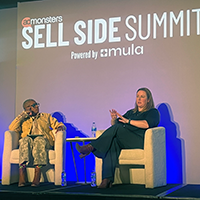When you are making a lot of money, you probably don’t care whether the Wall Street Journal covers your industry or even your company. The validation might be nice, but whether they cover it or not doesn’t impact the success of the business. In this respect, certain successful companies, not to mention the individuals behind them, deep down inside want this type of exposure. Other companies and individuals within an industry do not. This has been the case of the domain name industry.
The domain name industry has industry publications, user forums, service providers, and even conferences. It has people who make a little bit of money and those who earn a lot of money. The domain industry also has its share of issues, i.e. practices that make money but at the expense of a positive user experiences. All of these things exist in other areas too – paid search, organic search, affiliate, etc., but there is something about the domain business that attracts fascination, wonder, and envy.
For years the domain industry stayed out of the limelight even when it seemed unlikely. Even when a known domainer went to jail for allegedly sending people who typed misspellings of Disney related names to porn sites, very little got published. For reasons not so obvious, it escaped the virulence and subsequent legislation that befell both spam and adware. In fact, many of the behaviors that led to the downfall of both email and adware have existed within the domain industry. Again, even after a flare-up that lands the industry in mainstream press, journalists and entrepreneurs seemed to glance over the underlying opportunity. That is until now.
Having assembled a collection of articles written within the past six months, I believe the domain industry has hit that tipping point, where it can no longer operate in a bubble – a ragtag group of moneymaking specialists with limited need to consult the corporate world. Whether domain holders like it or not, the corporate world has set its sites on them and their almost billion dollar business. Similar to the increased corporate attention, I predict articles about the space will begin to increase in frequency and speculation / discussion on the blogosphere.
While I have had some involvement in the industry for almost five years (which is pretty short in the domain world) and written on Internet advertising for two, I have largely avoided writing about the domain space. Why? Because I, through my employer, have a vested interest in the domain space, so there was no reason to invite competition by letting others know such a space exists. That, I believe, no longer is the case, making it the right time to provide a look at this exiting, addictive, and often lucrative business. So, with that longer than usual introduction, let us begin.
I registered my first domain in 1998 when trying to pick out a business name for a venture that never really got off the ground. This was just after I graduated from college, although, I started to think about domains in a limited fashion in 1994 after first being introduced to web browsing. I recall a conversation I had with my hall-mate / good friend / cancer survivor Mark McGrath suggesting that I bet someone could make money by registering names that didn’t exist. At that time I was thinking along brand lines, wanting to register brand names and sell them to the rightful owners. I was not alone in that thought. The biggest difference being that others acted on it and through their efforts, the term cyber-squatting came into existence.
Most people today associate the Internet with sites, each site having a domain name. The Internet, though, existed long before domain names. System administrators, programmers, and Internet historians among others can tell you that underlying each domain name is a set of numbers, which any computer connected to the Internet will have. The InterNIC website provides a great explanation saying, “Every computer on the Internet has a unique address – just like a telephone number – which is a rather complicated string of numbers. It is called its "IP address" (IP stands for "Internet Protocol").” Except for Rain Man though, not everyone can remember a long string of numbers, which is why around 1990, early developers focused on the burgeoning Internet created a system by which names could be used instead of numbers. The solution was the Domain Name System, created by Paul Mockapetris.
Here is where things get confusing, and it’s primarily because of the various entities involved as the transition from numbers to names took place (not that the history of the Internet and world wide web up until this point is simple). There are quite a few entities, and I believe the reason rests in the inherent difficulty of taking something that began as a tool for research along with military use, and transitioning it so that the Internet could become a tool for everyone. So, who are these entities? On the non-profit side we have the National Science Foundation. They, in a nutshell, are an independent federal agency that provides grants, i.e. money, for projects which “demonstrate the potential to contribute significantly to the body of scientific knowledge.” The Internet surely qualifies, and the NSF helped pay for the initial infrastructure from which the Internet grew.
In addition to the National Science Foundation, you had other non-profits helping maintain the central lists of addresses and their nick names. Once the domain name system had been finalized, i.e., letting people type in a “name.extension” instead of a string of numbers, those who had been maintaining this yellowpages for computers decided that somebody else should take over, somebody that could service a broader market. As a result, the National Science Foundation created InterNIC (the Internet Network Information Center) in 1993 to “manage the allocations of addresses and management of the address databases.” Initially, three companies won contracts to play various roles in the allocation of addresses and names. The most important and the one still involved today is Network Solutions. They received the contract for the resolution of names to numeric addresses. If you wanted a domain name, you not only got it from them, but they also kept the master list that dictated which IP address correlated to which domains.
Another key player in this allocation of unique addresses for those connecting to the world wide web, was the Internet Assigned Numbers Authority. Unfortunately, for those using this piece in a history of domain names paper, I know not enough on them to provide information on their role and relationship to InterNIC. Luckily for me, while the IANA site still exists, in 1998 they, along with InterNIC were reorganized into the more commonly known entity, ICANN, the Internet Corporation for Assigned Names and Numbers, a California non-profit headquartered in Marina Del Rey.
ICANN is “it” when dealing with the assigning of domain names and IP addresses. Dot com domain names are but just one of the many extensions in use today. Most in our space have seen and or registered names with other extensions (known as top level domains) such as “.net” and “.org.” Together “.com”, “.net” and “.org” make up three of the generic top level domains. Web site del.icio.us on the other hand, uses a country code top level domain name. What should the country code extensions be? What should be the next generic top level domain name? Which companies get to manage the master list? These are all questions that ICANN works to answer, with their decisions effecting the entire web.
Well, we’re almost on to the really good stuff. So far, we’ve planted to seeds from which an understanding of today’s domain name landscape, specifically the commercial interest, will arise. This flashback to Web 1.0 and Domain Names 1.0 concludes by turning back to 1993 and time when Network Solutions began to administer domain names. Those first lucky, and very with it, souls didn’t have to pay anything, with names being snapped up at the rate of about 400/month. By 1994, that had increased to 2000/month, at which time a National Science Foundation advisory committee urged moving to a fee based system. It took until 1995 for that recommendation to take place. The joint NSI and NSF plan called for an initial registration fee of $100 for new names and a fee of $50 for names previously registered and subsequent year registration of new names. Even so, the domain name rush had begun, but the hockey stick shaped slope of domain name registrations didn’t start to occur until later. The forces behind the Internet land grab and the conclusion of this domain piece can be found here.



